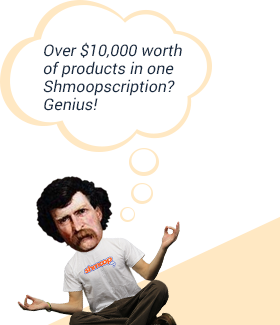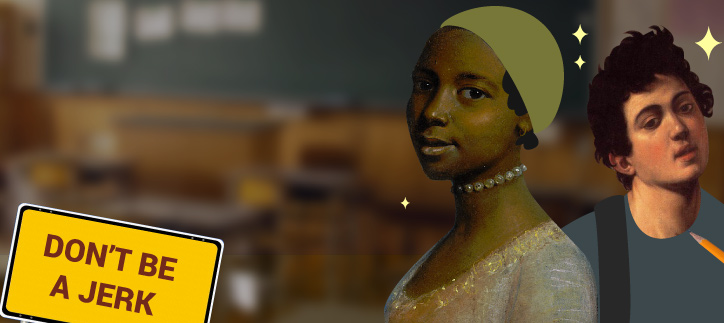Looking for more PBIS resources? Check out all of our Teacher Guides and Online Courses here.
We know from Brad Pitt that the Seven Deadly Sins are Gluttony, Sloth, Lust, Greed, Wrath, Envy, and Pride. But do all these have to be sins? Eating too many cookies might give us a stomachache, but it's hardly deadly… unless we do it every day. Perhaps the difference between being a sin and merely sinful—in the decadent dessert definition of the term—is moderation.
If you want to greedily gorge yourself on our teaching guides, though, we won't stop you. But this guide on pride (pardon the rhyme) has just the right number of lessons to keep you satisfied. (The rhyming won't stop!)
In this guide you will find
- a lesson on picturing someone's personality with an actual picture. Those who are prideful in their drawing skills will be put to the test.
- discussion questions on the differences between having a healthy sense of pride, and being an arrogant a… aardvark. "Arrogant aardvark" is a real phrase, right?
- a classroom pride party activity. Who doesn't love a party?
These are lessons you can be proud of. Not too much, but just enough.
DAY 1: YOU ARE WHAT YOU DRAW
Introduction
Today, students will be looking at ways to establish a healthy sense of pride in themselves. Additionally, students will play a friendly game of pictelaphone in order to highlight the uniqueness found in individuals' personalities. For homework, students will be gathering significant objects that represent who they are.
Before you get started, here's a video you can show to your class.
Key Skills and Learning Objectives
- Build personal pride.
- Define pride and how it can be applied to the individual.
- Develop appreciation for personal and peer personality.
- Gain more confidence and self-esteem.
- Develop confidence through group participation.
Homework
- Yesterday: Define what healthy pride is, as well as what it is to be overly proud or arrogant.
- Today: Students will gather objects from home that represent who they are.
YOU ARE WHAT YOU DRAW
Materials Needed:
Picture Personality handout
Pen/Pencils
Estimated Time to Complete: 45 minutes
At this point, defining pride is going to be the best place to start. Have you ever thought of the difference between being proud and being proud? You haven't? Well, that's probably because people use pride as a criticism or a compliment. Basically, if anyone tells you that you should be proud, it's a good thing. If anyone mentions or comments on the fact that you're being proud, it's usually bad.
Yeah, it's complicated. Today, thinking about it is mandatory.
Being proud means that you give yourself (and others) credit where credit is due. You're satisfied and happy with an outcome or an accomplishment. You are able to take pride in others, objects, and places so much so that you're willing to go the extra mile to demonstrate it.
Being arrogant or conceited is when pride becomes excessive, which is usually when you begin to develop a superiority complex. You left the pride knob on all night and now you're overflowing with arrogance and self-righteousness. And you know that stuff doesn't come out of shirts easily.
You don't want to be arrogant. An arrogant person is also the dude that won't admit he's wrong, even when he most definitely is. Basically, he missed the whole week's lesson on responsibility and respect.
Today, we're talking about what it means to take pride in yourself. The best way to develop a healthy sense of pride is to examine all the things you're good at. Yes, you. Not the person next to you. For this exercise, don't compare yourself to others. Your level of pride is independent of how well others do. Plus, you're not always going to be the best at something, so quit chasing perfection.
And yes, we are focusing on skills and abilities for now. Acceptance is great and all, but having pride in something you didn't work to obtain (like your genetic traits, name, ethnicity) isn't the focus of this lesson.
[If you haven't already, arrange the desks so that they are in a circle. Either that, or move to an area where all students can sit in circles on the floor. Groups should be between 6 and 9 students, if possible.]
In a moment, you will all be getting a sheet of paper.
At the top, there's a space to write a statement. The statement must be about an accomplishment that you're proud of.
In the bottom space provided, be sure to write your name. That way, everyone knows who to reference in their own statements. Hold tight—it'll make sense momentarily.
Here are some statement ideas to get you started:
- Alexander won a gold medal in the Ultimate Frisbee League.
- Mrs. Sanchez ran a marathon last fall.
- Samantha created a popular app.
After you're finished writing your statements, fold back on the line. There are instructions designating which line so it shouldn't be too confusing.
After your fold, pass your paper to the person on your left. Now you have a new person's paper. Carefully look at what was just written. Then, draw a picture of the statement in the space provided. [Give students 60 seconds.]
Now fold your drawing over (think a burrito-style roll) so that the previous statement is completely covered up.
Pass to the next person on your left. Now you will be looking at the previous picture drawn and writing a statement about what you see.
Things go on like this until you're all laughing your heads off, or until you've run out of room on your paper. Whichever comes first. When you get a new piece of paper, look at the statement or drawing and follow the instructions.
[Once you've reached the bottom of the papers, instruct students to hand the picture/statement page that they have back to its owner.]
Everyone unravel your pages. Take a peek and have a laugh. Hand the paper back to the person whose name was the subject of the statements. [Allow students one minute to share among themselves and read their own story quietly. Ask for a few volunteers to share their "stories" and pictures with the class. Students will be sharing the funny progression, but also personal accomplishments. A win-win.]
Wrap Up
Good times had by all, right? Although this was a silly activity (see: amazingly fun), it also had a point about experiencing pride in ourselves as individuals. Think about it. Each person that wrote on those papers experienced a different perspective. Their personalities shined through as they sought to determine what the picture was or how a statement should be drawn. Isn't it fun to be so different?
[Here are some discussion questions:]
- What did this activity tell us about our differences?
- How would this activity have been different if we were all the same and had the same thinking patterns?
- Why should we be accepting of who we are and who we are becoming?
- Is it okay to like yourself?
HOMEWORK
We're going back to first grade for this one—show and tell time. Find 3-5 small items that represent your accomplishments, your likes, your wishes, and/or who you are. Bring these items in a small box or bag. Be prepared to tell the class about each object and what it means to be you.
DISCUSSION AND ESSAY QUESTIONS
- How does accepting ourselves lead to a healthy sense of pride?
- When does pride become arrogance?
- How do you think developing a strong sense of self-pride happens?
- Can you be arrogant and have pride?
- Can too much pride ever be "dangerous" or negative? How do you know when you've reached that point?
- Phil forgot to feed Fluffy today. When Mom approached him about it, he refused to admit any wrongdoing and blamed Mom for not reminding him. What kind of pride is Phil demonstrating? How do you know?
- How can a healthy sense of pride benefit you as an individual?
- Can pride be used as a way to build up yourself and others? How?
- Where does self-control and discipline come into having a health sense of pride in yourself?
- What is the difference between self-pride and self-esteem?



